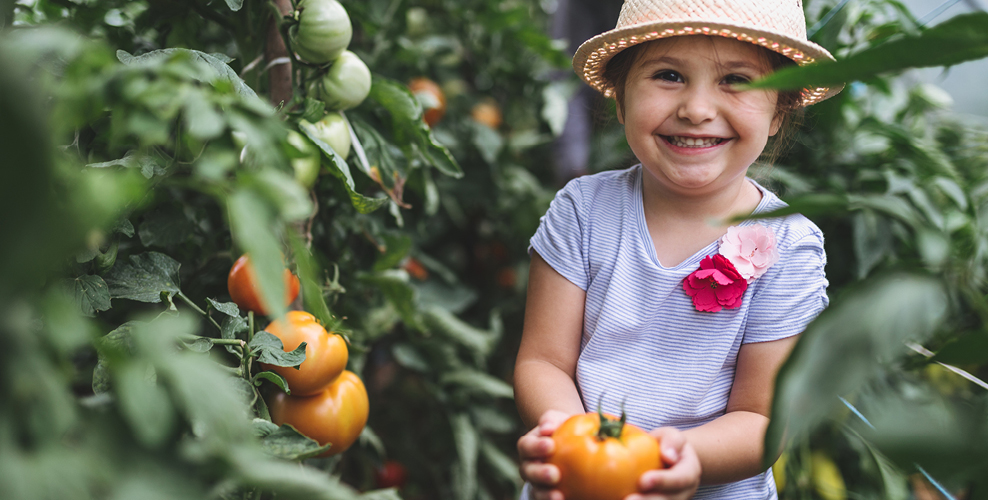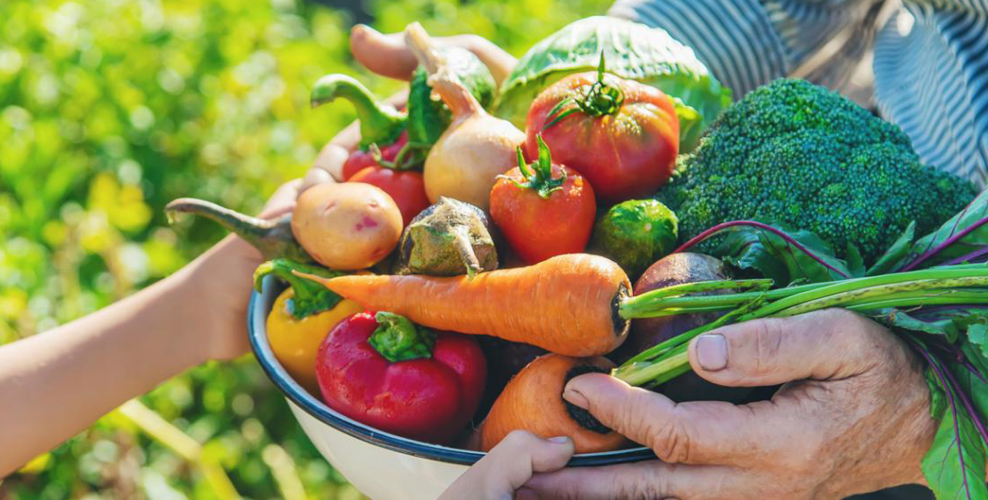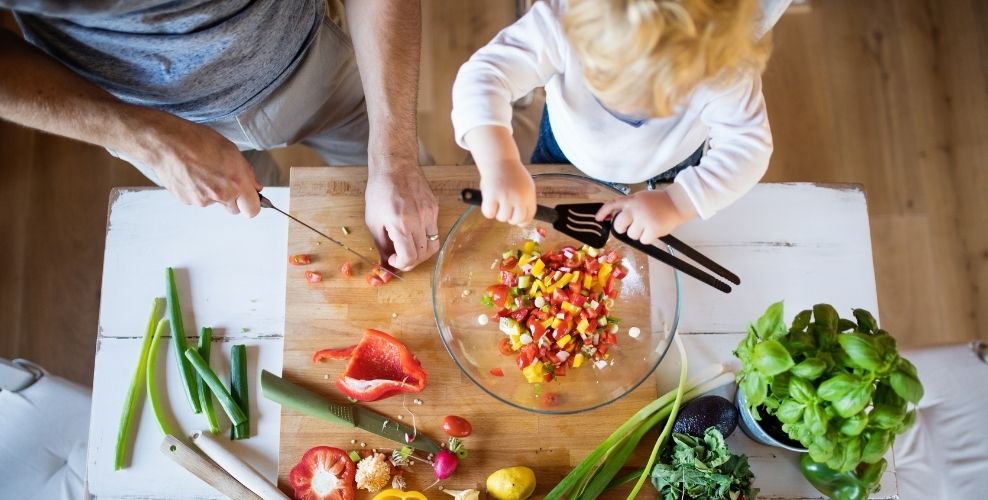9 ways to get your kids to eat more veggies (some of them are super-sneaky!)

If you’re not managing to get your child to eat enough veggies, don’t feel guilty, because it’s an extremely common problem.
Research from the Australian Bureau of Statistics (ABS)1 indicates that around 95% of 4-11 year olds and more than 80% of 2-3 year olds in Australia don’t eat the recommended amounts of vegetables each day.
How many vegetables should kids eat?2
Before we start, it’s important to know what you’re aiming for, which is the target quantity of vegetables you’d ideally like your child to be eating, a quantity that will vary according to their age.
Aim for 2.5 serves of veggies (including legumes) for 2-3 year olds each day, increasing to 4.5 serves for children aged 4-8 years.
From 9 years old onwards, kids should be eating roughly the same quantity of vegetables as adults, that is, 5 serves per day, and a slightly higher 5.5 servings for boys aged 12 years and older.

What’s a ‘serving’ of vegetables for kids?3
If you’re using a kitchen scale to measure portions, a standard serving of vegetables is about 75 grams.
But most parents don’t weigh their kids’ food, so in more practical terms, think of a serving as 1 cup of leafy greens or raw salad vegetables, or ½ cup of most cooked vegetables or legumes.
For example, each of the following is one serving of vegetables:
- 1 cup of mixed salad
- 1 medium-sized tomato
- ½ cup cooked peas or pumpkin
- ½ medium-sized potato
What if your child won’t eat vegetables?
The good news is that with persistence and some clever strategies, it IS possible to teach most kids to embrace vegetables.
Read on to discover nine of our top tips - they’re all backed by science, and many of them come highly recommended by parents in our Fusion Facebook and Instagram communities too.
1. Be persistent – it pays off!
It may seem like you’re fighting a nightly battle to get your child to eat better – and one that you’re sometimes tempted to give up on!
But taking a long-term, consistent approach really is worth it because on average, children need to be offered a new food about eight to ten times at regular intervals (such as weekly) before they’ll accept it and readily incorporate it into their diets4.
In part this is because children are sometimes intimidated by new things. With repeated exposure, what was once strange becomes familiar, and the idea of giving a new veggie a try becomes less threatening to them4.
That means that even if your child is groaning and turning their nose up at what you put on your plate, you’ll probably get the outcome you want in the long run if you keep persisting!4
2. Turn food into a fun, multi-sensory experience

Eating is a multi-sensory experience, especially for kids, because they’re constantly encountering new foods, tastes and textures.
They learn about which foods they like and dislike in multiple ways, including by using their senses to taste, see and smell4 - and their senses of touch and hearing can play a valuable role too.
Fusion follower marlimaree puts it like this: ‘Our little baby boy loves playing with his food. You can see him touch it, look at it and taste it. Exploring and playing with food is key for getting little ninjas to learn to love food.’
You can accelerate the process of helping veggies feel familiar and unintimidating by finding fun ways to include sensory encounters with them into your child’s day.
Here are some ideas to get you started – you’ll notice they incorporate all the senses, not just taste4:
- Prompt your child to pay attention to their sensory experiences while eating, for example by saying things to them like: "I love the crunch of this carrot between my teeth and the sound it makes when I munch on it, how about you?"
- Ask your child to feel and describe the different textures of the whole raw vegetable, the sliced or grated vegetable, and the cooked vegetable
- Encourage your child to smell the difference in the way a vegetable's scent changes when it's whole, chopped up, and then cooked
- Tell or read stories about vegetables together. The Charlie and Lola book, I will not ever NEVER eat a tomato is a great place to start
- Sing songs featuring veggies and get dancing too. How about The Broccoli Bunch, by The Wiggles?
3. Empower them to choose (your way)
We all like to feel we have a choice in life, and kids feel this desire for autonomy even more powerfully than adults5.
Empower your child to feel that eating vegetables is their choice by giving them a small set of options.
Your goal is to let them feel like they’ve got some control, but sneakily set them up with a trick question in which veggies are always the winner.
For example, ‘Would you like spinach, corn or both for dinner tonight?’.
Our Instagram follower @molly_isabel has a clever strategy for working with this concept, saying: ‘I let the kids initiate what they want to eat – pizza, chips, cake, ice cream, WHATEVER… but I make a healthy version of it.’
4. Stay positive
Encouraging your child to try new tastes and revisit familiar foods in a positive and encouraging way will typically be more successful than pressuring, criticising or punishing them when they don’t4.
This is because creating a positive eating environment may make your child more inclined to expand their food horizons4.
It’s a strategy that further reinforces their sense of autonomy and empowerment6, in the same way that offering them a choice does.
So, while it might be tempting to withhold dessert if your child doesn’t eat their vegetables or to make them stay at the table until they finish what’s on their plate - it’s possible that using those more controlling kinds of techniques to get kids to eat their veggies may even back fire5 over the long-term.
5. Get them involved every step of the way

Asking your child to help you with meal preparation is a time-honoured way of getting them to be open to trying a wider range of foods.
Where possible start their involvement even earlier in the process by getting them planting and nurturing the veggies in your garden.
Both activities tap into your goals of helping kids develop a deep familiarity with vegetables and encouraging them to feel empowered and in control.
As Mandy Gehard shared on our Facebook page, ‘A small veggie patch works wonders. The kids plant the vegetables themselves, harvest them and then help cook them. And they’re so much more interested in eating different foods when they know they’ve ‘made’ this amazing vegetable all by themselves too’.
6. Use rewards wisely
When kids are old enough, consider offering them a reward for trying the vegetable that you're keen for them to start eating - perhaps a sticker on a chart for every time they eat a piece of broccoli or carrot.
It’s important that you don’t use food as a reward though (especially treats or dessert) because doing so may lead them to only eat their veggies because they know there’ll be ice cream afterwards4-6.
7. Go for bite-sized, finger-friendly portions

Choosing foods that kids can eat with their fingers encourages them to experience new food textures4, and also makes eating more manageable and less daunting for them.
It’ll make life easier and keep both you and the kids on track if you’ve always got veggies on hand, chopped up and ready to munch on, so try keeping some kid-sized servings ready to go in the fridge so you don’t need to start prepping when someone is hungry5.
8. Sneak some veggies in when they’re not looking
Every parent alive has probably hidden veggies in their children’s favourite foods at some time or other.
It sounds sneaky, but it does work! Scientists call it ‘flavour-flavour learning’ because it combines a flavour kids do like with one that they don’t in order to make the one they consider unpleasant more palatable to them5.
For instance, our Instagram follower @mrs_rama1 swears by adding a bunch of spinach to her children’s banana smoothies, then tells them it’s green because it’s a Hulk smoothie.
9. Be a great role model
Lastly, don’t forget that even when you’re not talking to them about food, your child learns much of their eating behaviour from you.
When they see you eating healthy food and expressing enjoyment of it, they naturally want to join in6.
So, feel free to go over the top about how much you love your veggies and how happy they make both your tummy and your tastebuds when in your child’s hearing, but save the ‘sometimes’ foods for after they’ve gone to bed.
References:
- ABS. National Health Survey: First Results, 2017-18 — Australia, Table, 17.3 Children's consumption of fruit, vegetables and selected sugar sweetened and diet drinks, Proportion of persons. Published 2018 and accessed Oct 2020 from https://www.abs.gov.au/AUSSTATS/[email protected]/DetailsPage/4364.0.55.0012017-18?OpenDocument
- National Health and Medical Research Council. Australian dietary guidelines. 2013: Canberra. https://www.eatforhealth.gov.au/sites/default/files/content/n55_australian_dietary_guidelines.pdf
- eatforhealth.gov.au. Serve sizes. Published 2015 and accessed Oct 2020 from https://www.eatforhealth.gov.au/food-essentials/how-much-do-we-need-each-day/serve-sizes
- Nekitsing, C. et al. Curr Obes Rep, 2018;7(1):60-7
- DeCosta, P. et al. Appetite, 2017;113327-57
- Yee, A.Z. et al. Int J Behav Nutr Phys Act, 2017;14(1):47
















